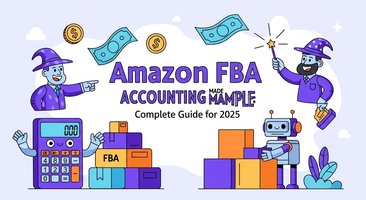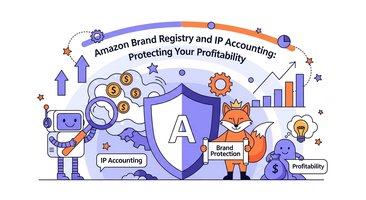Amazon promotions and Lightning Deals can drive significant sales volume and visibility, but they also create complex accounting challenges that many sellers overlook until they significantly impact profitability. Understanding how to properly account for discounted sales, promotional fees, and the long-term impact of promotional strategies is crucial for maintaining accurate financial records and making informed business decisions.
This comprehensive guide will help you navigate the accounting complexities of Amazon's promotional ecosystem while establishing systems to track promotional performance and optimize your promotional strategies for maximum profitability.
Understanding Amazon's Promotional Landscape
Amazon offers numerous promotional tools designed to help sellers increase visibility, drive sales, and compete effectively in the marketplace. Each promotional type has distinct accounting implications and cost structures that require proper tracking and analysis.
Lightning Deals Overview
Lightning Deals represent Amazon's most prominent promotional format, featuring limited-time offers with significant discounts that appear on Amazon's deals pages and in customer recommendations.
Key Lightning Deal characteristics:
- Time-limited offers (typically 4-12 hours)
- Quantity limitations based on inventory
- Prominent placement on Amazon's deals pages
- Required discount percentages (typically 15-80%)
- Lightning Deal fees ranging from $150-$300 per deal
Coupons and Discounts
Amazon Coupons provide ongoing promotional opportunities with more flexible terms and lower costs than Lightning Deals.
Coupon program features:
- Flexible discount amounts and percentages
- Customizable duration and quantity limits
- Lower promotional fees ($0.60 per redeemed coupon)
- Integration with Amazon's coupon discovery pages
- Stackable with other promotional offers
Prime Exclusive Discounts
Prime Exclusive Discounts target Amazon's most valuable customers while providing promotional visibility and potential for increased conversion rates.
Prime discount characteristics:
- Exclusive access for Prime members
- Flexible discount structures
- Enhanced visibility in Prime member browsing
- No additional promotional fees beyond standard referral fees
- Integration with Prime member marketing channels
Buy One Get One (BOGO) Promotions
BOGO promotions encourage larger order sizes while providing perceived value to customers, though they require careful profitability analysis.
BOGO considerations:
- Complex inventory tracking requirements
- Margin impact analysis needed
- Customer acquisition vs. profitability balance
- Potential for increased customer lifetime value
- Accounting complexity for bundled transactions
Promotional Fee Structure and Accounting
Amazon promotional fees vary significantly across different promotional types, requiring systematic tracking to understand the true cost of promotional activities.
Lightning Deal Fee Structure
Lightning Deal fees represent significant costs that must be factored into promotional profitability calculations:
Base Lightning Deal Fees:
- Standard categories: $150 per Lightning Deal
- Electronics and other competitive categories: $300 per Lightning Deal
- Additional fees may apply during peak periods
- No refunds for unsuccessful Lightning Deals
Additional Lightning Deal Costs:
- Inventory allocation requirements
- Potential stockout costs if demand exceeds expectations
- Opportunity costs of discounted pricing
- Customer service increases during promotional periods
Coupon and Discount Fees
Coupon fees are more variable and directly tied to customer redemption:
Per-Redemption Fees:
- $0.60 per redeemed coupon
- No upfront fees for coupon creation
- Fees only charged when customers use coupons
- Volume discounts may apply for large sellers
Discount Cost Considerations:
- Direct revenue reduction from discounted prices
- Potential for increased sales volume
- Customer acquisition and retention benefits
- Impact on average order values and margins
Promotional Inventory Allocation
Inventory commitment for promotions creates additional cost considerations:
Lightning Deal Inventory Requirements:
- Minimum inventory levels required for deal approval
- Inventory held exclusively for promotional periods
- Potential stockout costs if promotion exceeds expectations
- Storage fee implications for promotional inventory
Opportunity Cost Analysis:
- Revenue foregone from regular-price sales
- Inventory carrying costs for promotional stock
- Potential margin improvements from volume sales
- Long-term customer value from promotional acquisition
Revenue Recognition for Promotional Sales
Promotional revenue recognition requires careful consideration of timing, discount allocation, and customer incentive accounting.
Gross vs Net Revenue Reporting
Revenue reporting methods for promotional sales affect financial statement presentation and analysis:
Gross Revenue Method:
- Record full selling price as revenue
- Record promotional discounts as marketing expenses
- Provides clear visibility into promotional costs
- Separates pricing decisions from promotional strategies
Net Revenue Method:
- Record discounted price as revenue
- No separate promotional expense recording
- Simpler accounting treatment
- Less visibility into promotional impact
Timing of Revenue Recognition
Revenue recognition timing for promotional sales follows standard principles but requires attention to promotional period boundaries:
Point of Sale Recognition: Revenue is recognized when the customer completes the purchase, regardless of promotional pricing.
Promotional Period Boundaries: Ensure promotional sales are properly attributed to correct accounting periods for accurate performance analysis.
Return and Refund Considerations: Promotional sales may have different return patterns that affect revenue recognition adjustments.
Customer Incentive Accounting
Customer incentives like coupons and discounts require proper classification for accurate financial reporting:
Marketing Expense Treatment: Most promotional discounts should be classified as marketing expenses rather than revenue reductions.
Cost of Goods Sold Considerations: Some promotional structures may affect COGS calculations if they involve free products or bundled offerings.
Tax Implications: Promotional discounts may affect sales tax calculations and reporting requirements.
Profitability Analysis for Promotional Activities
Promotional profitability analysis requires comprehensive evaluation of both direct costs and indirect benefits to make informed decisions about promotional strategies.
Direct Cost Calculation
Direct promotional costs include all fees and discounts directly attributable to promotional activities:
Lightning Deal Cost Analysis:
- Lightning Deal fees ($150-$300)
- Revenue reduction from discounted pricing
- Additional referral fees on promotional sales
- Incremental fulfillment and storage costs
Coupon Cost Analysis:
- Per-redemption fees ($0.60 per coupon)
- Discount amounts provided to customers
- Administrative time for coupon management
- Customer service costs for coupon-related inquiries
Indirect Benefit Measurement
Indirect promotional benefits often justify promotional costs even when direct profitability appears negative:
Visibility and Ranking Benefits:
- Improved organic search rankings from increased sales velocity
- Enhanced product visibility in Amazon's recommendation algorithms
- Competitive positioning improvements
- Long-term traffic increases from promotional exposure
Customer Acquisition Value:
- New customer acquisition through promotional visibility
- Customer lifetime value from promotional customers
- Cross-selling opportunities from promotional purchases
- Brand awareness improvements from promotional exposure
Break-Even Analysis
Break-even calculations help determine minimum performance requirements for promotional profitability:
Lightning Deal Break-Even:
Break-Even Units = Lightning Deal Fee ÷ (Regular Margin - Promotional Margin)
Coupon Break-Even:
Break-Even Redemptions = Fixed Promotional Costs ÷ (Coupon Value + $0.60 Fee)
ROI Calculation:
Promotional ROI = (Additional Profit - Promotional Costs) ÷ Promotional Costs
Seasonal and Strategic Promotional Planning
Strategic promotional planning requires understanding seasonal patterns, competitive dynamics, and long-term business objectives to optimize promotional effectiveness.
Seasonal Promotional Strategies
Seasonal promotions require careful planning to maximize impact while managing inventory and cash flow:
Peak Season Planning:
- Q4 promotional opportunities and increased competition
- Inventory allocation for promotional periods
- Cash flow impact of increased promotional spending
- Coordination with advertising and marketing campaigns
Off-Season Promotions:
- Inventory clearance and turnover improvement
- Customer acquisition during lower competition periods
- Brand building and market share development
- Preparation for peak seasonal periods
Competitive Promotional Response
Competitive dynamics significantly impact promotional effectiveness and require strategic consideration:
Market Positioning:
- Promotional pricing relative to competitors
- Timing of promotional activities
- Promotional frequency and customer expectations
- Differentiation through promotional structures
Defensive Promotions:
- Response to competitive promotional activities
- Market share protection during competitive periods
- Customer retention through promotional loyalty programs
- Brand positioning maintenance during price competition
Technology and Automation for Promotional Accounting
Automated promotional tracking becomes essential as promotional activities scale in frequency and complexity.
Manual Promotional Tracking Challenges
Manual promotional management creates several operational and accounting challenges:
Complex Data Management: Tracking multiple promotional types, fees, and performance metrics manually becomes overwhelming.
Accuracy Issues: Manual calculation of promotional ROI and profitability analysis is prone to errors and inconsistencies.
Timing Problems: Manual systems struggle to capture promotional performance data in real-time for quick optimization decisions.
Scalability Limitations: Manual processes don't scale effectively as promotional activities increase in frequency and complexity.
Automation Benefits for Promotional Management
Automated promotional tracking provides significant advantages:
Comprehensive Data Integration: Automatically combine promotional fees, sales data, and profitability metrics for complete promotional analysis.
Real-Time Performance Monitoring: Track promotional performance as it occurs, enabling quick adjustments and optimization decisions.
Accurate Cost Allocation: Systematically allocate promotional costs and benefits across products and time periods for accurate profitability analysis.
Historical Analysis: Maintain detailed historical records of promotional performance for strategic planning and optimization.
Klavena's Promotional Categorization
Klavena provides automated promotional transaction categorization designed specifically for Amazon sellers:
Automatic Fee Classification: All Amazon promotional fees are automatically identified and properly categorized for accounting purposes.
Promotional Sales Tracking: Promotional sales are automatically distinguished from regular sales for accurate performance analysis.
Cost Allocation: Promotional costs are systematically allocated across products and time periods for comprehensive profitability analysis.
Integrated Reporting: Promotional performance data flows directly into financial reports and business analytics for strategic decision-making.
Best Practices for Promotional Accounting
Implementing these best practices ensures accurate promotional accounting while supporting effective promotional strategies.
Strategic Promotional Planning
Systematic promotional planning optimizes both accounting accuracy and business performance:
Annual Promotional Calendar: Develop annual promotional schedules that align with business objectives, seasonal patterns, and competitive dynamics.
Budget Allocation: Establish promotional budgets based on historical performance, growth objectives, and available resources.
Performance Targets: Set specific performance targets for different promotional types to guide optimization decisions.
Competitive Analysis: Regularly analyze competitive promotional activities to inform strategic promotional planning.
Accurate Cost Tracking
Comprehensive cost tracking ensures accurate promotional profitability analysis:
Direct Cost Monitoring: Track all direct promotional costs including fees, discounts, and incremental expenses.
Indirect Cost Allocation: Systematically allocate indirect costs like customer service, inventory management, and administrative time.
Opportunity Cost Analysis: Consider opportunity costs of promotional inventory allocation and pricing strategies.
Long-Term Impact Measurement: Track long-term benefits like customer acquisition, lifetime value, and brand building effects.
Performance Optimization
Continuous optimization improves promotional effectiveness over time:
A/B Testing: Test different promotional structures, timing, and targeting to optimize performance.
Customer Segmentation: Analyze promotional performance across different customer segments to improve targeting.
Product Performance Analysis: Evaluate promotional effectiveness across different products and categories.
Seasonal Optimization: Adjust promotional strategies based on seasonal performance patterns and market dynamics.
Common Promotional Accounting Mistakes
Understanding common mistakes helps avoid costly errors that can distort promotional analysis and business decision-making.
Mistake #1: Incomplete Cost Tracking
Overlooking promotional costs understates the true cost of promotional activities:
- Not tracking Lightning Deal fees properly
- Ignoring indirect costs like customer service increases
- Failing to account for opportunity costs of discounted pricing
- Not allocating administrative time for promotional management
Mistake #2: Short-Term Focus
Excessive focus on immediate ROI can lead to suboptimal promotional strategies:
- Not considering customer lifetime value from promotional acquisition
- Ignoring long-term ranking and visibility benefits
- Failing to account for brand building effects
- Not evaluating competitive positioning improvements
Mistake #3: Inconsistent Performance Measurement
Inconsistent measurement approaches make it difficult to optimize promotional strategies:
- Using different ROI calculations for different promotional types
- Not standardizing performance measurement periods
- Failing to account for seasonal variations in promotional effectiveness
- Not comparing promotional performance to organic sales baselines
Tax Implications of Promotional Activities
Promotional tax treatment requires careful consideration to ensure compliance while maximizing deductions.
Deductible Promotional Expenses
Most promotional costs qualify as deductible business expenses:
Direct Promotional Costs:
- Lightning Deal fees
- Coupon redemption fees
- Promotional discount amounts
- Advertising costs for promotional campaigns
Indirect Promotional Costs:
- Administrative time for promotional management
- Customer service costs related to promotions
- Inventory management costs for promotional stock
- Professional services for promotional strategy development
Sales Tax Considerations
Promotional sales tax treatment varies by jurisdiction and promotional structure:
Discount Impact: Promotional discounts may affect sales tax calculations based on local regulations.
Coupon Treatment: Different jurisdictions may have varying treatments for manufacturer vs. retailer coupons.
Documentation Requirements: Maintain detailed records of promotional activities for sales tax compliance and audit purposes.
Future-Proofing Promotional Strategies
Sustainable promotional strategies require adaptation to changing market conditions and Amazon policy updates.
Evolving Promotional Landscape
Amazon's promotional ecosystem continues evolving with new features and requirements:
New Promotional Types: Stay informed about new promotional opportunities and their accounting implications.
Policy Changes: Monitor changes to promotional policies, fees, and requirements that affect promotional strategies.
Competitive Evolution: Adapt promotional strategies as competitive dynamics and customer expectations evolve.
Technology Integration: Leverage new promotional management tools and automation capabilities as they become available.
Long-Term Strategic Considerations
Sustainable promotional success requires balancing short-term performance with long-term business objectives:
Brand Building: Ensure promotional strategies support long-term brand building rather than just short-term sales.
Customer Relationships: Focus on promotional strategies that build customer loyalty and lifetime value.
Competitive Positioning: Use promotions strategically to improve competitive positioning and market share.
Profitability Sustainability: Maintain promotional strategies that support long-term profitability and business growth.
Conclusion
Amazon promotional activities offer significant opportunities for sales growth and competitive positioning, but they require sophisticated accounting approaches to manage effectively. Success requires understanding the complete cost structure of different promotional types, implementing systematic tracking and analysis systems, and making strategic decisions based on comprehensive performance data.
Effective promotional accounting combines accurate cost tracking with strategic performance analysis to optimize promotional strategies for both short-term results and long-term business success. The complexity of promotional accounting makes automation essential for maintaining accuracy while scaling promotional activities.
Klavena's promotional categorization capabilities provide the foundation for effective promotional accounting by automatically tracking promotional costs, categorizing transactions appropriately, and integrating promotional performance data with overall business analytics. This automation enables sellers to focus on strategic promotional optimization rather than manual accounting tasks.
Whether you're just beginning to use Amazon's promotional tools or looking to optimize existing promotional strategies, investing in proper accounting systems and strategic analysis capabilities will provide the foundation for sustainable promotional success and profitable business growth.





